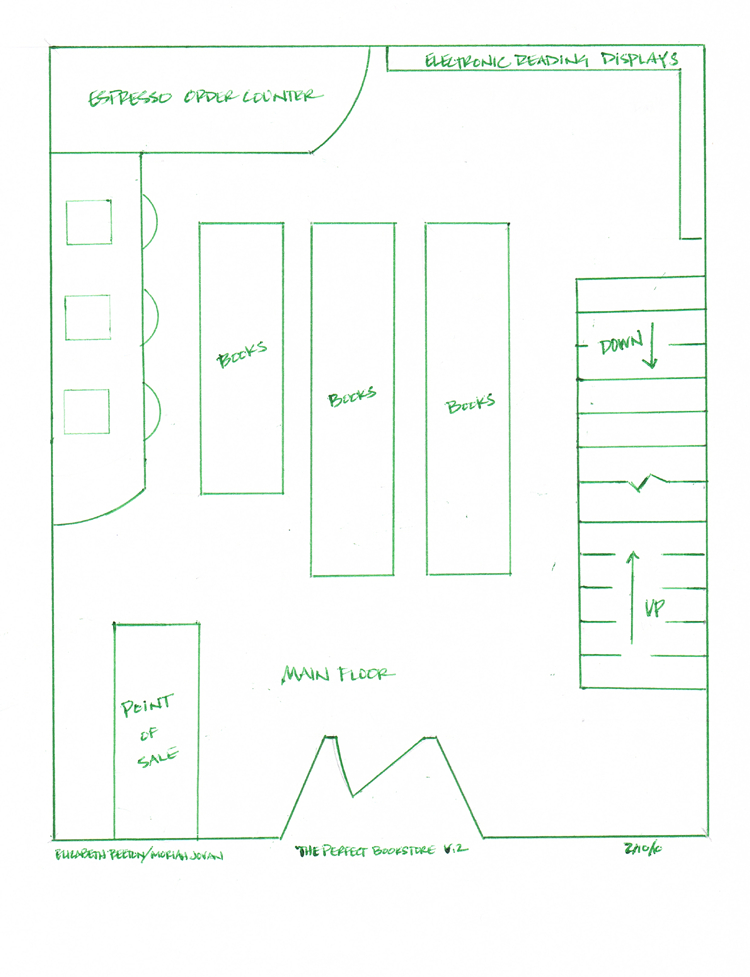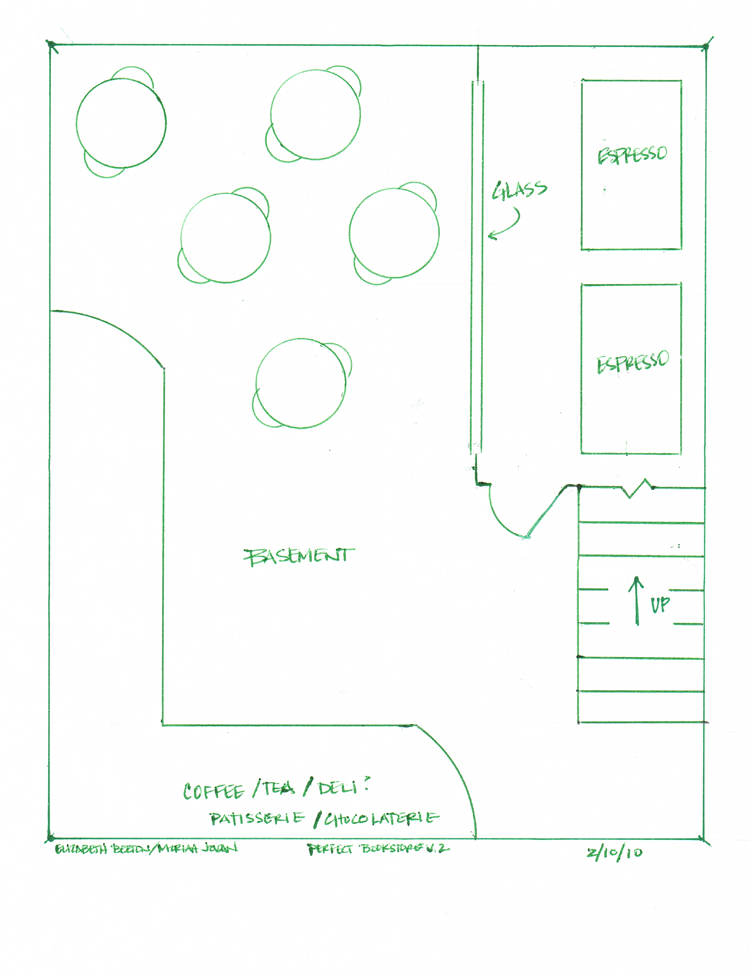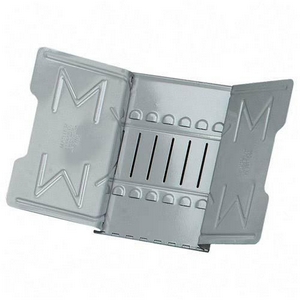Go read this and all the comments, then come back. Now we’ll recap.
Footprint: A narrow storefront on the county square of a small midwestern city, with three floors. (I didn’t bother with the third floor sketch. Use your imagination.)
Complaint: It’s not a “real” bookstore.
Disclaimers: 1) I’m not an industrial designer so don’t ding me on scale, lack of bathrooms, and walking space, etc etc etc. 2) This is an IDEA. Don’t take me to task as if I’m on the cusp of taking over the world and implementing all these in a grand sweep tonight while you sleep.
Goal: To make the bookstore a destination, not a stop on your to-do list.


I. Print on Demand
This is the key to blending the Espresso and “real” books:

- Do you know what it is? It’s a catalog holder, like the ones at auto parts stores, where you stand at the counter and find which part you need for your car. Only these won’t have catalogs. They’ll have cover flats, separated by genre, subdivided by subgenre.
- You will sit at the counter and flip through them. You will have a little wifi gizmo tied to the store’s computers. You will enter your account number and you will order what you want by pointing the gizmo at the bar code. Your order will go downstairs to the Espresso machines.
- If you want an electronic version, it can be wifi’d do your device and/or you can have a CD/DVD burned, and/or you can have a download link emailed to you.
- If you have already ordered what you want from a home computer or smartphone or other device, it will be waiting for you at the customer service counter (“Espresso Order Counter”).
- The store will have a website that functions like any other ebook third-party retailer.
II. eReading
You may purchase the most current electronic reading devices and be advised by someone who actually knows what they are, how they work, and can teach you. There will be workshops.
III. “Real” books
- The store will have at least one copy of whatever the buyer knows his customers like. He won’t have to order more because he’ll “Espresso it.” That way, customers can browse actual books.
- The third floor will be dedicated to art books, children’s books, collector’s editions, with plenty of comfortable chairs. Yes. You will have to climb stairs. Get over it.
IV. Sustenance
In the basement there will be a coffee/tea bar with pastries and chocolate, possibly a small deli. There will be ample room to hang out.
V. Extras
- You can watch the Espresso machines through the glass window.
- There will be book club nights.
- The Espresso books will always be brought upstairs so you don’t have to go downstairs if you don’t want to.
There you go. Blast away.

I like this concept a lot better than the first one. Nicely balanced between print, POD and e, while being event-friendly and allowing for nichefication. The two Espressos are a significant investment, but the right community and a smart strategy, it’s all win.
We’ll critique it tomorrow during the Roundtable! 🙂
The first one was just a toss-off one Sunday morning. I’ve been thinking about this one ever since that one stirred up so much comment.
You where I think these would really be great, is as a replacement for college bookstores–swap out some coffee and add sweatshirts and notebooks.
Here’s my rationale: (1) a lot of print textbooks are already short-run, so the cost difference with print-on-demand isn’t as great. (2) Textbooks seem like a great genre to convert to e only–make topical material easy to update–but so far the kids don’t like ’em. I think that survey was done at Truman State, where the college even gave (rented? loaned?) the kids the readers as well as the books. (3) Let already-strapped colleges park their money someplace other than book inventory.
The problem is that the only reason I go to a bookstore is to physically look at the book and see if it’s what I really want. Otherwise, I order from Amazon.com or get the book from the library.
POD would be a good idea for textbooks except it needs to be modified to CPOD. Crappy print on demand. Cheap paper, cheap ink, barely usable for one time use. (My daughter needed a Personal Finance book for a college class. New it’s $220. From online booksellers it was $160. I bought the international version from eBay via Thailand for $50. The only differences? It’s softcover and uses slightly lighter weight paper which actually makes it lighter and more portable. Now if they could have printed it on even crappier paper using ink that fades in a year, perhaps it would have run $35.
A counter-point is that this should just be an eBook since the thing gets a new revision every year so you can’t buy used anyway. And if you go one step further and have the eBook not be completely brain dead, you could have charts that animate and instant quizzes and all sorts of things that actually enable learning, but which will never happen [in part because educators are perhaps the least visionary people I’ve ever dealt with as a group. The most computer illiterate too.])
Yes. You will have to climb stairs. Get over it.
Um. That was incredibly disrespectful to those of use who are disabled and unable to climb stairs, y’know? (Yes, I realize this isn’t a real store, but that statement is just… gah. *wanders off, trying to let my blood pressure get back down to normal.)
Glenda, my post is in respect to an already-existing building whose top floor is not now nor ever was nor ever will be accessible because it’s an historic building and is exempt. (Nor is the basement in use.)
Yes, I do think it’s a bit, ah, strange that someone would take offense over a building whose specs have been identified, and whose use is hypothetical to begin with. I also have the disclaimer that I’m not an industrial designer and not to take me to task for things like no bathrooms, no emergency exits, no space between the bookshelves to turn around twice if you’re built like a brick shithouse. There are A TON of things wrong with it, not just disabled inaccessibility.
I assume, in general, that Americans (including I) aren’t used to having to climb stairs because we’re used to sprawling chain bookstores, big-box stores, and malls. If anyone should be offended by my tone, it’s people who just don’t want to climb stairs. Including me.
Lastly, the comment itself was a tongue-in-cheek jab at Guy LeCharles Gonzales upthread who whined at me on Twitter one day about not wanting to climb the stairs.
I’m sorry that you were offended, but I’m more sorry I can’t make an offhand remark without offending someone.
.
Sounds brilliant.
@MoJo: My complaint about your original second floor wasn’t about walking up the stairs, it was that putting the “real” books up there seemed like a condescending afterthought. I still believe any bookstore, current or future, will need to have physical books on the premises to browse because serendipity will remain a critical aspect of discovery as well as incremental sales.
Ah, well. It was an afterthought. Not condescending. Two for two!
Dude waits for three.
I’m not going to dwell too much on the physical layout. This concept is much closer to where I think the future bookstore is going. But I’d add some things:
– Displays of books that have been hand-selected by a knowledgeable staff; things like “Staff Picks”, books that are receiving much attention from the media (whatever constitutes ‘media’ in this future landscape), backlist favorites, etc.
– The bookstore of my dreams has and will always have handwritten shelf-talkers that make it impossible to resist buying books. These add character, flavor and personality to the store, sets it apart from any others.
– Community Education: Your concept fits my definition of what a bookstore is: a place to acquire information, entertainment, and inspiration. With the exception of the physical book, existing bookstores have given much of that away for free. It’s going to have to come at a cost in this model in order to keep the lights on and the Espresso machines running. My idea: community learning on the order of The Learning Connection in New England or The Learning Annex in NYC. Less expensive than a college extension program, this model pays a small honorarium to members of the community with expertise (financial planner, knitting instructor, wine shop owner) to lead workshops in the store. Attendees of workshops pay an affordable fee. Instructor provides store with a list of recommended books around the subject in question. Instructor gets a chance to connect and spread the word about his/her business. Community members get affordable knowledge. Store gets income. A full schedule of these workshops with accompanying book sales can be a substanial income stream for the store if programmed and managed appropriately.
I ALMOST put a table up there in front of the bookshelves for that very purpose, but it got a mite busy.
Re: Community education and textbooks (mentioned by Joe & Ann Marie above).
In the original Perfect Bookstore post, I mentioned that this town has a small liberal arts college about 10 blocks from the county square (this bookstore), and I think I mentioned textbooks there.
So in my mind, I DO see A) ebook textbooks and B) college involvement with this version.
If I were drawing a footprint from scratch, though, I’d have a U-shaped building with a large courtyard in the middle to facilitate the workshops, wine tastings, book club meetings, etc., and the courtyard would be open to foot traffic, so you wouldn’t have to go IN the bookstore to sit in the courtyard.
@Joe: Did you go to BYU? Remember Kinko’s just south of campus? They did that.
Textbooks in Japan (and the rest of Asia) follow the CPOD approach–inexpensive and disposable. Here is an interesting comparison. When I was in grad school, many of my “textbooks” were Xeroxed compilations of journal articles selected by the professor. We’d pick them up at the copy center in the basement of the JKHB.
I haven’t been to Blockbuster in years (Netflix only these days). But the last time I went, the place felt run-down and seedy. B&N does get the mood and ambiance right, even if I can’t remember the last time I actually bought anything there. And I’m always struck that the typical community library arranges the shelves more logically and has a more user-friendly IT system.
I LURVE your idea! Wish I had gobs of money and could do it. I would have a used book section too.
Have you seen this video vision of a combined ebook and print book store in a French company’s video? Possible ou probable ? English subtitles
“The french publishing group Editis’s short fictional video is about the likely future of books. This video does not represent Editis’s digital strategy regarding the epublishing market. However, it does hope to open discussions on the different economic models and the functionalities of future ebook readers.
Filmed in 2007, this is the latest version with english subtitles. ”
Reading your ideas reminded me somewhat of that video vision.
Addendum: You need to fast forward to 0:47 for the video to actually start.